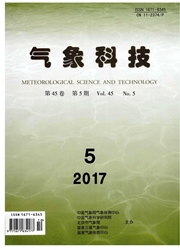

 中文摘要:
中文摘要:
利用加密观测资料和NCEP/NCAR 1°×1°的6 h再分析资料,对2006年12月25-27日发生在我国中东部地区的一次罕见强浓雾天气过程从大尺度背景、动力和热力机制等方面进行了诊断分析。结果表明:①本次过程大雾发生阶段近地面风速很小,在0.3-2.9 m/s之间变化;浓雾发生阶段风速在0.3-2.4 m/s之间变化;15 m能见度维持阶段风速在0.8-1.1 m/s之间变化;②虽然浓雾发生前的很长一段时间内水汽条件差,而且后期西风槽影响时也无降水,但是槽前西南气流的持续水汽输送使得强浓雾形成所必须的水汽条件得到满足;③在大雾发生前,稳定层结逐渐建立并在大雾期间稳定维持,稳定层结的建立和维持对浓雾的形成、持续有重要作用;日出后首先在较高层出现不稳定层结,继而下传到底层,稳定层结被破坏,大雾减轻或消散;④第1阶段(25日夜里至26日上午)强浓雾出现前,能见度出现多次急速大幅振荡,在第2阶段(26日傍晚至27日上午)则未出现类似现象。
 英文摘要:
英文摘要:
With the intensive observation data and NCEP/NCAR reanalyzed data,an unusual heavy fog process occurred over the east-central China from 25 to 27 December in 2006 is analyzed in aspects of the large-scale synoptic condition and dynamic and thermodynamic mechanisms.It was shown that the fog occurred while the near-ground wind velocity varied from 0.3 to 2.9 m/s and the dense fog occurred while the wind velocity varied from 0.3 to 2.4 m/s and the visibility was within 15 meters when velocity was from 0.8 to 1.1 m/s.Although vapor condition was bad and rainfall didn't occur within a few days before the heavy fog,the continuous vapor transportation of the southwestern air current before a trough offered plentiful vapor for the fog.The results also show that the stable stratification gradually established before the fog.At first,the instable stratification built at higher levels after sunrise,subsequently passed downward to lower levels,and then the inversion layer destroyed and the fog dispersed and cleared off.The results indicate that the visibility changed rapidly and violently before the first stage of the severe heavy fog but it did not before the second stage.
 同期刊论文项目
同期刊论文项目
 同项目期刊论文
同项目期刊论文
 期刊信息
期刊信息
